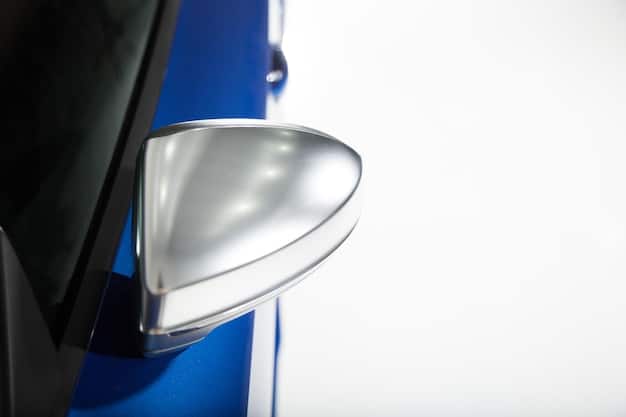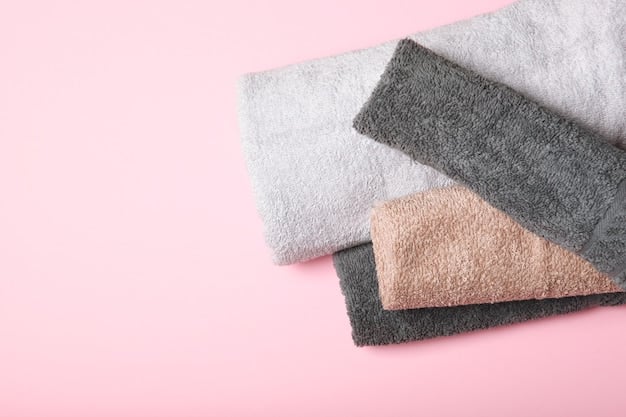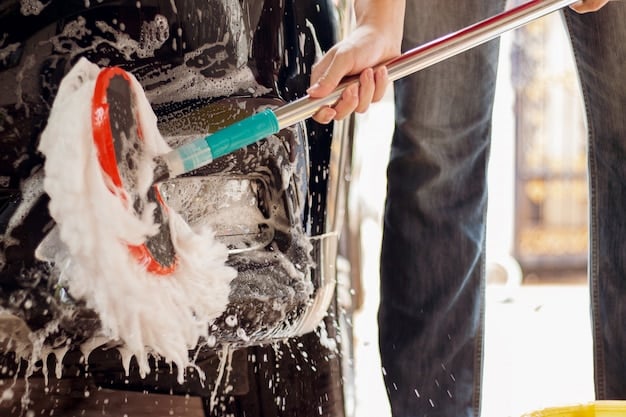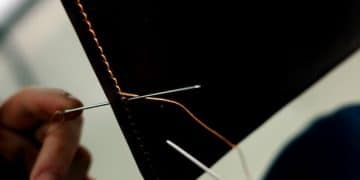The Art of Automotive Detailing: Achieving Showroom Shine

The art of automotive detailing involves a meticulous process of cleaning, correcting, and protecting a vehicle to restore and maintain its showroom shine, preserving its value and aesthetic appeal.
The quest for a pristine, showroom-worthy finish for your beloved vehicle often leads to the fascinating world of automotive detailing. The art of automotive detailing: Achieving a showroom shine and protecting your investment encompasses far more than a simple car wash, diving deep into the science and techniques required to not only clean but also protect and enhance your car’s appearance.
Understanding Automotive Detailing
Automotive detailing is an intricate process, a labor of love that goes beyond regular washing. It’s about restoring and protecting every inch of your vehicle.
This meticulous approach involves a multi-stage process that can transform a tired, worn-out car into a stunning masterpiece on wheels.
What Detailing Isn’t: Dispelling the Myths
Many mistakenly think that detailing is simply a glorified car wash. However, detailing is far more comprehensive, focusing on both cosmetic and protective measures.
Unlike quick washes that often rely on harsh chemicals and automated processes, detailing is a hands-on process, using gentle products and careful techniques.
- Detailing involves correcting paint imperfections, something a regular wash doesn’t address.
- Detailing focuses on long-term protection, while washing provides immediate but fleeting cleanliness.
- Detailing encompasses the entire vehicle, including interior, engine bay, and undercarriage.
In essence, detailing is about preserving your vehicle’s value and appearance for years to come.
Essential Tools and Products for Detailing
Equipping yourself with the right tools and products is paramount to achieving professional-level results. The market is flooded with options, but selecting the best will save you time and frustration.
Investing in quality products not only produces better results but also helps protect your vehicle’s surfaces from damage.

Microfiber Towels: A Detailer’s Best Friend
Microfiber towels are indispensable for detailing. Their unique fiber structure gently lifts dirt and grime without scratching delicate surfaces.
Different types of microfiber towels are used for various tasks, from washing and drying to polishing and waxing.
- Plush microfiber towels are ideal for drying, thanks to their high absorbency.
- Waffle-weave towels are excellent for glass cleaning, leaving a streak-free finish.
- Short-nap towels are suited for compound and polish removal, ensuring a clean surface.
Choosing the right microfiber towel for each task is key to minimizing the risk of scratching and swirl marks.
The Interior Detailing Process
The interior of your car is where you spend most of your time, making it essential to maintain a clean and comfortable environment. Interior detailing focuses on deep cleaning and protecting all surfaces.
From removing stubborn stains to conditioning leather, interior detailing can revitalize your car’s cabin, making it feel like new again.
Vacuuming: The Foundation of Interior Cleaning
Vacuuming is the first step in interior detailing, removing loose dirt, crumbs, and debris from carpets, seats, and crevices.
Using a vacuum with various attachments allows you to reach tight spots and effectively clean different types of surfaces.
- Crevice tools are perfect for cleaning along seat edges and in narrow gaps.
- Brush attachments are ideal for gently agitating carpet fibers and upholstery.
- Hose extensions allow you to reach under seats and in hard-to-reach areas.
Regular vacuuming not only improves the appearance of your interior but also helps prevent the buildup of allergens and odors.
Exterior Washing and Drying Techniques
The exterior wash is a crucial step in detailing, removing dirt, grime, and contaminants that can damage the paint. Using proper techniques ensures a thorough cleaning without causing swirl marks or scratches.
Drying the vehicle after washing is equally important, preventing water spots and preserving the finish.

The Two-Bucket Method: Minimizing Swirl Marks
The two-bucket method is a widely recommended technique for washing cars safely. It involves using two buckets: one with soapy water and one with clean water for rinsing your wash mitt.
This method helps to keep dirt and contaminants from being reintroduced to the paint surface, reducing the risk of swirl marks.
- Fill one bucket with a high-quality car wash soap and water, following the manufacturer’s instructions.
- Fill the other bucket with clean water for rinsing your wash mitt.
- After washing a section of the car, rinse the mitt thoroughly in the clean water bucket before re-dipping it into the soapy water.
By keeping your wash mitt clean, you minimize the amount of dirt and grime that comes into contact with your car’s paint.
Paint Correction: Removing Imperfections
Paint correction is the art of removing imperfections like swirl marks, scratches, and oxidation from your car’s clear coat. This process involves using polishing compounds and machines to level the paint surface.
Proper paint correction can dramatically improve the appearance of your vehicle, restoring its gloss and reflectivity.
Understanding Different Types of Paint Imperfections
Identifying the type and severity of paint imperfections is crucial for choosing the right correction methods.
Common imperfections include swirl marks, caused by improper washing techniques, scratches from road debris, and oxidation, caused by sun exposure.
- Swirl marks are fine, circular scratches that appear as hazy reflections in direct sunlight.
- Scratches can range from minor surface blemishes to deep gouges that penetrate the clear coat.
- Oxidation appears as a dull, faded look, often accompanied by a chalky residue.
Correcting these imperfections requires a variety of techniques, from light polishing to more aggressive compounding.
Protecting Your Investment: Waxing and Sealing
After achieving a flawless finish through detailing and paint correction, it’s essential to protect your investment with a wax or sealant. These products create a barrier against environmental contaminants, UV rays, and water damage.
Regular waxing or sealing not only preserves the appearance of your car but also helps to extend the life of the paint.
Choosing the Right Protection: Wax vs. Sealant
Both waxes and sealants offer protection for your car’s paint, but they differ in terms of composition, durability, and application.
Waxes are typically made from natural ingredients, such as carnauba wax, providing a warm, rich glow and excellent water beading. Sealants, on the other hand, are synthetic polymers that offer longer-lasting protection and resistance to harsh chemicals. Consider the following:
- Waxes: Natural ingredients, warm glow, excellent water beading, and shorter lifespan (typically 1-3 months).
- Sealants: Synthetic polymers, longer-lasting protection, resistance to chemicals, and a more reflective shine (typically 6-12 months).
The choice between wax and sealant depends on your preferences, climate, and maintenance routine.
| Key Point | Brief Description |
|---|---|
| 🧼 Washing Techniques | Using the two-bucket method to minimize swirl marks. |
| ✨ Paint Correction | Removing imperfections to restore gloss and reflectivity. |
| 🛡️ Protection | Applying wax or sealant to guard against environmental damage. |
| 🧽 Interior Cleaning | Vacuuming, stain removal, and surface protection. |
Frequently Asked Questions (FAQ)
▼
Detailing is more thorough than washing, focusing on cleaning, correcting paint, and protecting surfaces. Washing primarily removes surface dirt, while detailing enhances and preserves the vehicle’s overall condition.
▼
Detailing frequency varies based on environmental factors and usage. A full detail every 4-6 months is advisable for maintained vehicles, while more frequent detailing might be necessary for cars exposed to harsh conditions.
▼
DIY detailing is possible with the right tools and knowledge. However, professional detailers offer expertise and access to advanced equipment, ensuring optimal results, especially for paint correction and protection.
▼
Essential detailing products include car wash soap, microfiber towels, glass cleaner, interior cleaner, wax or sealant, and wheel cleaner. Quality products and applicators make a significant difference in achieving professional results.
▼
Protecting your car’s paint involves using proper washing techniques, such as the two-bucket method, avoiding abrasive materials, and applying wax or sealant regularly. Paint protection film offers an additional layer of defense.
Conclusion
Mastering the art of automotive detailing not only elevates the aesthetic appeal of your vehicle but also serves as a proactive measure in preserving its value and longevity, ensuring that your investment remains protected and gleaming for years to come.





